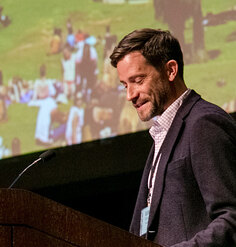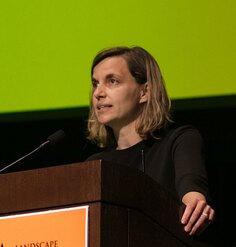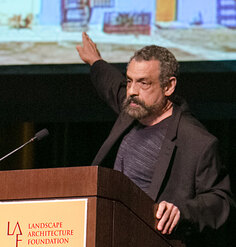Topology and Landscape Experimentation
By Christophe Girot
This presentation was part of the Landscape Architecture Foundation’s The New Landscape Declaration: A Summit on Landscape Architecture and the Future held in Philadelphia on June 10-11, 2016. LAF asked a diverse group of leading minds to write a “Declaration” reflecting on the last half century and offering bold ideas for how landscape architecture can make its vital contribution in response to the challenges of our time.
Christophe Girot
Professor, ETH Zurich
Zurich, Switzerland
Christophe Girot is professor and chair of landscape architecture in the Architecture Department of ETH Zurich. He received a dual master of architecture and landscape architecture from the University of California, Berkeley, and was chair of design at the Versailles School of Landscape Architecture. At ETH he cofounded the Landscape Visualizing and Modelling Laboratory (LVML) with Professor Adrienne Gret-Regamey in 2010.
* Affiliation at the time of the Summit
Topology and Landscape Experimentation
by Christophe Girot
The Romans believed in three kinds of nature: an untouched wilderness, productive agriculture, and the garden as cultural and symbolic artifact. Today, only one kind of nature remains where humankind dominates, seeking to show both a mastery over, and an understanding of, the processes of natural creation. This scientific approach to nature is monitored, programmed, fabricated, and maintained through empirical methods of trial and error with the help of advanced cybernetics and modeling.
Redefining nature: questioning nature as fabrication
The late ethnologist Claude Lévi-Strauss gave a speech in 2005 entitled “On the Growing Difficulty of Living Together”1 where he reckoned that between the time when he was born in the early twentieth century and now, the world had gone from 1.5 billion inhabitants to more than 6 billion. The population had more than quadrupled in his lifetime and was still increasing logarithmically with each decade. In an ethical stand, he postulated that the disappearance of species was a fundamental breach in the integrity of creation, and hence the rights of humanity should cease as soon as they encroached on the survival of other species.
Now that we humans number more than seven billion, unbounded human growth will cause immeasurable repercussions on both the cultural and biological diversity of the planet, ultimately jeopardizing mankind itself. We have entered an age of complete natural fabrication, where landscape architects are asked to reinvent forms of nature that respond appropriately to the unwieldy challenges of climate change and rising waters. Such fabrications require a proactive understanding of ecology and diversity and will produce landscapes that challenge conventional wisdom, completely redefining the understanding of nature embedded in our collective consciousness.
Resilient design: inventing new topical landscapes
Natural fabrication will undoubtedly require sustained multidisciplinary exchanges and enough creative power to invent new forms of landscape that can match the formidable societal and environmental challenges ahead. John Hennessy, former president of Stanford University, created a cross-disciplinary joint program at the beginning of the twenty-first century that merged schools—ranging from engineering to the arts—and helped break down conventional barriers between disciplines, thus allowing creative interaction within established structures and the questioning of old habits.2 By training generations of engineers, designers, and artists to work together in synergy, to think differently when faced with unforeseen challenges in the environment, we, too, could become more responsive creatively.
Resilient landscape design requires a significant change of attitude, through the invention of new terrain topologies that will perform better in an environment with shifting boundary conditions. New topical landscapes will emerge that better express the specific needs and priorities of a world exceeding seven billion inhabitants. Designers may observe, understand, and acquire knowledge about a particular situation, but they will also need to react and think creatively in synergy with others about solutions for the future. A topical selection of projects will suppose a fundamentally new mode of interaction between disciplines, where landscapes will be prototyped, simulated, and tested in a series of feedback loops.
This process of dialogue and interdisciplinary design iteration will undoubtedly give birth to new forms of natural systems and will have deep repercussions on the secular values that we presently attribute to nature. Landscape education should, therefore, encourage creative invention through reinforced dialogue with other disciplines, developing design tools and methods that are better adapted to our rapidly changing world. Topical landscapes produced through this exchange will challenge many preconceptions and bring renewed confidence and creative ability to our field by fostering innovation through experimentation in design.
Commonalities and divides: toward a culture of difference
Recognizing and fostering regional and cultural differences in landscapes will probably be the strongest challenge of this global age. As with the disappearance of species, countless cultural traditions related to landscape will disappear in coming decades due to the increased political, economic, and environmental pressures of globalization. French geographer Augustin Berque reminds us of the very particular relationship that humans have with their natural environment, a relationship that differs strongly and symbolically from one society to another, from one language to the next.3 Berque defines this bond with nature as the ecumene and reminds us of the unfathomable differences between cultures of the Orient and the Occident, and the North and the South. The ecumene expresses, therefore, a society’s attachment to a particular landscape reality, an ontological predisposition toward nature, where the relationship to landscape is understood as a set of strong beliefs and signifiers. Our relationship to the world is the complex product of language, work, culture, and myth, and the idealized expression of this faith in nature often merges at the cusp of strong cultural divides, where things can barely be explained, let alone be sensed. Commonalities and environmental concerns will thus continue to face prevailing linguistic and cultural divides, nurturing strong distinctions and discrepancies between human societies. As cultures disappear, other hybrids will arise, underlining the prevalence of local lore over globalization, and each landscape will thus become an invitation to express a culture of difference in an act of superb creative defiance.
1. The speech, entitled „La difficulté croissante de vivre ensemble“ (“On the Growing Difficulty of Living Together”), was written and presented by Claude Lévi-Strauss in 2005 upon receiving the 17th International Prize of Catalonia.
2. Reinhold Steinbeck, “Building Creative Competence in Globally Distributed Courses Through Design Thinking,” Revista Communicar 19, no. 27 (2011): 27-34.
3. Augustin Berque, Histoire de l’Habitat Idéal: De l’Orient vers l’Occident (Paris: Editions du Félin, 2010), 45. Berque speaks about a succession of fundamental upheavals in our relationship to the world, for instance, though Chinese Culture at the time of the Six Dynasties, when the relationship between nature and culture was dematerialized and inverted through the monastic practice of the ecumene.











